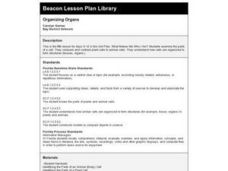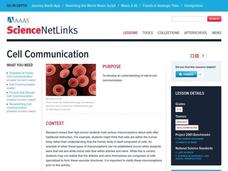Curated OER
Skin: The Behavior and Health Connection
Students explore how personal behavior can affect health, especially the health of your skin. They become better aware of how their personal behavior and the environment can have a considerable impact on their health in general. Students...
Curated OER
Puffin Patrol
Bird diversity and the majestic puffin are the topics of today's lesson. Children discuss and look at images of puffins, and then they use felt to put a puffin body together. After that they talk about what and how puffins eat. They get...
Curated OER
The Science of Respiration and Blood Circulation
Fifth graders study how respiration and circulation are connected. In this respiratory lesson plan students complete several activities to better understand heart rate and carbon dioxide in the body.
Curated OER
Organizing Organs
Fifth graders research plant and animals cells and create a Venn Diagram to show the similarities and differences.
Curated OER
Cell Cookies
Fifth graders, in groups, create a plant or animal cell out of cookies, frosting, and candy pieces.
Teach Engineering
Designing a Robotic Surgical Device
The engineering design process meets laparoscopic surgical robots with an activity that is the last part in a series of 10 and brings all the lessons of the unit together. Teams design and build a remotely controlled laparoscopic device....
Curated OER
Digestion and Nutrition
Debunk the theory that a soda-and-candy diet is a nutritionally sound concept! Learners first read 2 paragraphs of background information covering essential nutrients, digestion, and homeostasis. Then, they use the information they...
Curated OER
Obesity
Students examine how hormones affect different tissues. In groups, they make their own hormone-receptor model and identify the characteristics of tissues that respond to the different hormones. To end the lesson, they examine the role...
Curated OER
Cells All Around
Students measure the size of an epithelial cell and to estimate the number of epithelial cells in a given area of the body. After watching a video on cells, student groups perform an experiment using a microscope to view some of their...
Curated OER
Talking 'Bout Regeneration
Learners research the regenerative capabilities of certain organisms. They present their findings at a student regeneration symposium aimed at exploring the possibilities of human regeneration.
Curated OER
The Circulatory System
In this circulatory system worksheet, students read a paragraph about the function of the different organs that make up the circulatory system. Then students complete 3 short answer questions.
Curated OER
What is an Animal?
In this flatworm body plan worksheet, students compare the body plans of several worms. Students answer several questions based upon the given diagrams of a cross section of the different body plans of each worm.
Curated OER
Anatomy Review
For this biology worksheet, learners examine the internal functions of the human body while considering the factors needed to explain the physiological reactions.
Curated OER
Arthropods
For this arthropods worksheet, students will identify 3 different arthropods and compare these organisms' breathing structures: gills, book lungs, and tracheal tubes. This worksheet has 3 fill in the blank and 6 short answer questions.
Curated OER
Anatomy and Physiology "Quickies"
Young scholars use a variety of creative writing tools within this assignment: poems on particular organ systems, write a short story and/or create a word graph. They are involved in a demonstration of lactic build up in the muscles, a...
Curated OER
Case Study Two: Shark Dissection
High schoolers read an article on sharks prior to beginning a dissection lab. As part of the lab, students identify differences between the shark anatomy and human anatomy and hypothesize why those differences exist.
Curated OER
Sponges
For this sponges worksheet, high schoolers will explore the characteristics of sponges including their different types of cells and body structures. Students will also determine how sponges reproduce. This worksheet has 3 short answer...
Curated OER
Building a Circulation City
Students identify the different organ systems found throughout the human body. Using a model, they explain and draw the flow of blood and name the parts of the circulatory system. They create their own circulation city in which to show...
Curated OER
Making Mummies
Students examine how mummies are made. In this ancient mummification lesson, students discover types of mummies and discuss the environments naturallly preserve bodies. Students research noteable mummy discoveries and present...
Curated OER
9 Phyla of the Animalia Kingdom.
Students identify characteristics of all 9 phyla of the Animalia Kingdom. They create a table of the 9 phyla and research a representative organism for each.
Curated OER
Secrets of the Ocean Realm - Survival in the Sea
Students determine the sequential links in a marine food chain and identify the roles that various organisms play in this chain. Students develop charts as visual aids for illustrating marine food chains.
Curated OER
Sizing Up the Supersize Croc
Students examine and compare traits of humans and crocodiles. In this crocodile lesson students use a ratio to estimate the height of a person and compare that to a crocodile.
Curated OER
Protection, Support, and Locomotion
In this vertebrate skeleton activity, students will read a paragraph about the function of bones, muscles, and skin. Then students will complete 6 short answer questions.
Curated OER
Cell Communication
Students clarify common misconceptions about cells. They assess initial knowledge of cells and cell behavior, read and discuss an article and consider the role of cell communication in the diseases of diabetes, multiple sclerosis and...























